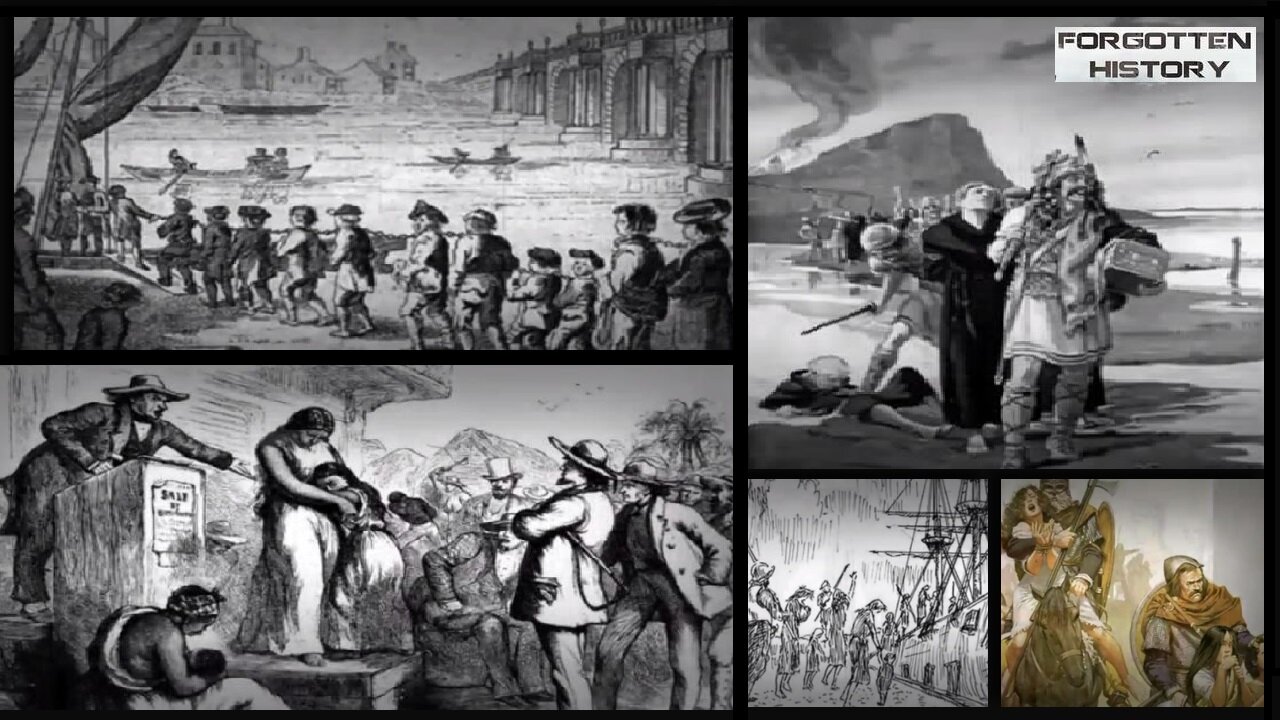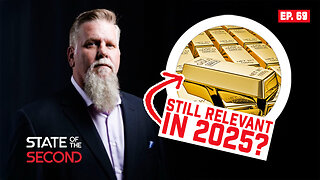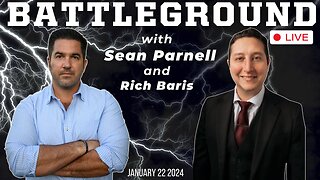Premium Only Content

TRUTH about the Irish - First slaves brought to the Americas - Forgotten History (Feb 9, 2023)
Slavery is perhaps one of the oldest profit making endeavors in human history and the Irish were a special target for a thousand years, persecuted by one faction or another, to include enslavement and indentured servitude. But were they the first slaves in the Americas? Find out here. Written and hosted by Colin D. Heaton. The Forgotten History Channel is a 10th Legion Pictures Production.
==============================================================================
Patreon page: / forgottenhistorychannel
Help support our channel: https://paypal.me/forgottenhistory
Join this channel to get access to perks:
/ @forgottenhistorychannel
==============================================================================
Thanks for watching. Please subscribe using the link below so we can continue making new content. Your subscription to the channel means a lot to us! / @forgottenhistorychannel
==============================================================================
About us: Host/Military Historian/Film Consultant/US Army and Marine Corps Veteran - Colin Heaton
https://www.heatonlewisbooks.com
Screenwriter/Director/Producer/US Marine Corps Veteran - Michael Droberg
https://www.michaeldroberg.com
https://www.10thlegionpictures.com
==============================================================================
Associated channel for sci-fi, fantasy, comedy, and film related topics:
/ 10thlegionpictures
==============================================================================
-COPYRIGHT DISCLAIMER UNDER SECTION 107 OF THE COPYRIGHT ACT 1976
- Copyright Disclaimer Under Section 107 of the Copyright Act 1976,
allowance is made for "fair use" for purposes such as criticism, comment, news reporting, teaching, scholarship, and research. Fair use is a use permitted by copyright statute that might otherwise be infringing. #forgottenhistorychannel
==============================================================================
Sources; Public Record Office, London
Calendar of State Papers Colonial, America and West Indies: Volume 1, 1574-1660. Originally published by Her Majesty's Stationery Office, London, 1860
TRANSCRIPT:
0:06
There has been an ongoing debate as to whether the Irish were the first
0:10
slaves in the Americas predating the first black African slaves by almost a decade.
0:16
Slavery is perhaps one of the oldest profit-making endeavors in human history and the Irish were a
0:22
special target for a thousand years. Throughout history the Irish were persecuted by one faction
0:27
or another, to include enslavement and indentured servitude. When did the Irish first become slaves?
0:35
How long did the selling of the Irish continue? Who is responsible? Hello I'm Colin Heaton former
0:41
soldier Marine Corps scout sniper history professor historian and book author and
0:46
we'll answer these questions and other issues on this segment of Forgotten History [Music]
1:01
Some groups deny the Irish slavery under English and later British rule, claiming that this was
1:07
nothing more than voluntary indentured servitude, which did exist. However, there are counter
1:13
arguments that will be challenged here.There is a legitimate dispute as to the numbers enslaved
1:18
especially during the 17th century before the Act of Union in 1707. The official British legal
1:25
terminology used was indentured servants whether the servants in question had willingly signed the
1:30
indenture contract to immigrate to the Americas or were forced to go. Many were forced. Therefore those
1:37
transported unwillingly and effectively sold were not considered to be indentured.
1:42
This included political prisoners, vagrants, convicts political activists, thieves prostitutes,
1:49
or people who had been defined as undesirable by the English government. The Irish introduction to
1:55
slavery was during the first Viking raid in the year 795 lasting through the mid 9th century. This
2:01
period saw the Irish killed and enslaved just like many other societies the Vikings attacked.
2:07
Most of these early raids were along the northern and eastern coast using hit and run tactics. The
2:13
Vikings would then flee with treasure and slaves and return to either their Holdings in Scotland or
2:18
back to Norway. Usually many slaves who were of value were ransomed back to their families but others
2:24
remained in captivity. Then from the year 837 onward larger targets such as the greater monastic
2:30
towns of Armagh, Glendalough, Kildare, Slane, Clonard, Clonmacnoise and Lismore were hit by larger forces.
2:39
These large-scale raids generally spare the smaller local churches and villages far inland, but slaves
2:45
were still taken, mostly to Scotland and Iceland. In 875 Irish slaves in Iceland launched Europe's
2:52
largest slave rebellion since the end of the Roman Empire, when Hjorleifr Hroomarsson's slaves
2:58
killed him and fled to Vestmannaeyjar.. In 841 the port that became known as Dublin was taken and occupied
3:05
by both Olaf and Ivar the Boneless, and by 853 this part of Ireland was a Norse trading center
3:12
and slaves were a large part of it. The slave trade did not stop with Ivar's death in 873. Finally in
3:19
902 driven out of Dublin by the combined forces of Brega and Leinster but the Vikings came back
3:25
in 914 and reclaimed all the territory taking more slaves but Irish resistance was not over. In 980
3:32
the Irish under mael Sechnaill Mac Domnaill, king of Meath fought and managed to defeat the Vikings
3:39
and freed all of their slaves. Some Vikings who remained assimilated and adapted to Christianity
3:45
and became part of Irish Society. The final nail in the coffin regarding Vikings holding land and
3:51
taking slaves was in 1014 at the Battle of Clontarf, when Brian Boru, high king of Ireland
3:57
attacked Dublin aided by his allies, the Limerick Vikings. They fought other Irish allied to the local
4:04
Vikings in Dublin and Boru's force one and all the slaves were again freed, thus ending
4:09
the legacy of constant Norse raids whether from Danes or Norwegians. The period forced enslavement
4:15
and severity ended a century after the Norman invasion of England in October 1066. Subsequent
4:22
Norman rulers of England eyed Ireland and slavery in its true form was abolished in 1102. In 1155
4:29
Pope Adrian IV supposedly gave Henry II of England a Papal Bull granting the king the authority to
4:35
invade Ireland. However many historians believe that this authorization was a forgery. Regardless
4:41
Henry II of England faced excommunication for the murder of Thomas a Beckett, the Archbishop
4:47
of Canterbury, so it is possible. However Adrian's successor Pope Alexander III granted the lands of
4:54
Ireland to Henry II although it was not his land to give. The Norman conquest of England and Ireland
5:00
were cataclysmic events that would shape Ireland's as well as world history and create tensions with
5:06
England for the next 800 years. The Normans were initially invited to Ireland by Dermot MacMurrough the
5:12
deposed king of Leinster. He is sometimes referred to as "Dermot of the Foreigners" and his grandmother
5:18
was the granddaughter of Brian Boru. In October 1171 King Henry II landed in Ireland and allowed
5:25
Dermot to recruit soldiers and mercenaries as Ireland was made up of several kingdoms
5:30
at war with each other. The city of Dublin and the surrounding area were under Norman occupation and
5:36
would be called "The Pale" or the "Safe Zone." Going beyond that was considered foolish, hence the
5:42
term we used today "Going Beyond The Pale" But the Normans ended the practice of slavery in Ireland
5:47
but not serfdom for at least a few hundred years. Despite the Norman abolishment of slavery serfdom
5:53
was still alive and well. Serfs were unlike slaves, bound to the land and the land meant
5:59
everything. So selling people into slavery would have left no one to farm and conduct agriculture.
6:05
Following the Battle of Kinsale in 1601 when the Irish and Spanish alliance was defeated the
6:12
Irish aristocracy fled to Europe, but the commoners remained and they left the power vacuum filled by
6:18
English nobles. Reports vary and the numbers are in dispute, but the high number is that English
6:23
forces had 30,000 captured Irish and Spanish soldiers; other sources say half that
6:29
number, around 15,000 were engaged with seven thousand to eight thousand being captured.
6:34
The Spanish allies were allowed to leave but not the Irish. In 1603 or 1604 King James I of
6:41
England crowned on March 23 1603 reportedly issued the Order of Banishment. This allowed those Irish
6:47
capture to be sold, a permanent banishment. After nearly a decade the king gave permission for the
6:53
English governor general to collect and sell the captured Irish soldiers as slaves and send them
6:59
to the New World in the Americas. In 1612 the first recorded Irish slaves were sold, possibly
7:05
to the Portuguese and taken to the Amazon River Basin in their colony in modern-day Brazil. This
7:11
brought them to the New World. There has been some dispute as to whether these people were indentured
7:16
servants or slaves but it is clear that they were forced out of Ireland to the New World so
7:22
it seems illogical and ridiculous to assume that they went voluntarily hence the status of slaves.
7:28
It has been chronicled that in 1625 James I's son Charles I issued the decree and
7:35
it may be possible before his death in March 1625. But given the timeline on James's death it would
7:42
appear that his son Charles probably did Issue the royal decree authorizing the Irish slaves. This
7:47
included prisoners captured, those deemed to be common criminals and rabble rousers who were sold.
7:53
They were to become the property of the English plantation owners in the North American colonies.
7:58
As a result, tens of thousands of Irish men and women were sent to the Eastern American colonies
8:04
as well as Guyana, Antigua and Montserrat, As well between 1629 and 1632 as other Caribbean locations
8:14
over the next few decades were infiltrated but the exact number may never be known. By
8:18
1637 approximately 69 percent of the population of Montserrat were Irish. Many were indentured
8:24
servants yet some were slaves. The rationale was simple: black slaves had to be purchased at a
8:30
cost of around 20 to 50 pounds sterling, a huge sum of money in those days. However Irish slaves
8:37
were sold for 900 pounds of cotton per person but also traded for tobacco and indigo in a straight
8:43
barter system. It would appear that the Irish then became the largest source of slaves for English
8:48
slave traders and plantation owners at that time far surpassing the African slave trade until the
8:55
early to mid 1700s. Between 1641 during the Irish Rebellion to 1652 it has been stated that over 550,000
9:05
Irish were killed by English forces and 300,000 more were sold as slaves, mostly
9:11
military-aged men. Their children, especially women and girls were sold and considered quite valuable
9:17
in the domestic service roles. The greatest perpetrator of this was Oliver Cromwell who
9:22
defeated Charles I in 1649 during the English Civil War and had him executed.
9:28
Cromwell as Lord protector waged a ruthless war against the Irish starting in 1649. By 1650 it
9:36
is claimed that nearly 29,000 Irish were sold to planters in St. Kitt. During the decade of the
9:42
1650s it is also claimed as well as disputed that around 100,000 Irish children generally from 10 to
9:50
14 years of age were taken from their parents and were also sold, and sold themselves also as slaves
9:56
or indentured servants in the West Indies, Virginia, the Carolinas and New England. It is also claimed
10:02
that between 1651 and 1660 the Irish slaves far outnumbered the colonists in all areas. In 1652
10:11
Cromwell ordered that 12,000 Irish were to be sold to Barbados and those numbers are not
10:17
in dispute, only their status. On 1 May 1654 his "To Hell or to Connacht Proclamation" was
10:25
issued during the active settlement of 1662. This was when the English began confiscating
10:30
all irish-held lands and the native Irish were relocated west of the Shannon River. Those who
10:36
resisted were sent to the West Indies as slaves or executed. His own words proclaimed quote; "Those
10:42
who failed to transplant themselves into Canuck or County Clare within six months shall be attained
10:48
of high treason or to be sent to America or other parts beyond the seas. Those banished who return
10:56
ought to suffer the pains of death as felons by virtue of this act without benefit of clergy," end
11:01
quote. The English could kill the Irish without penalty but selling them offered great profit. It
11:07
is claimed that over 80,000 more Irish were sold with 52,000 going to the colonies of Barbados and
11:13
Virginia, but again we cannot verify the exact numbers. Many argued that these were indentured
11:18
servants, not slaves, yet there are no records of contracts between those forcibly removed and their
11:23
benefactors. One may assume that given the barter system of using tobacco and cotton as a trade
11:29
item for workers that these deported Irish were in fact slaves. In 1656 the Council of State ordered
11:36
the Roundup of 1,000 Irish girls and 1,000 Irish boys in their early teens, even some children to
11:42
be rounded up and sold to Jamaican planters. These numbers are in dispute but do seem reasonable as
11:48
these would be children whose parents were already deported. Part of this order was an edict passed on
11:54
October 2nd 1665 which stated quote; "Upon report of Committee for America concerning proposals
12:00
for transporting persons from Long Island to Jamaica to confer with the Committee for Jamaica,"
12:07
end quote. The persons were Irish and no indentured servant would be released to go to Jamaica. These
12:13
had to be forcibly exported Irish who were already present in New York. In fact some
12:19
of the English receiving these Irish slaves seemed rather concerned, hence this following
12:24
report quote; "Commission appointing Cornelius Holland, Colonel Owen Rowe, Sir Thomas Roth
12:31
and 14 others accompany by the name of the governor and company of the city of London
12:36
for the plantation of the Somers Islands to take into consideration the present condition of those
12:42
plantations. Many well-affected persons there having been much oppressed and unjustly dealt
12:49
with in relation to matters of conscience," end quote. (Whitehall 1653 June 28th) This situation
12:57
with the forcibly removed Irish not being a people to take subjugation lightly appear to have created
13:02
the fear of an uprising and this seems to be explained in the White Hall document from November
13:07
18 1656 quote; "The Council of State to Captain Wilkinson importance of the Somers Islands to
13:15
the interest of the Commonwealth; supposition that the Spaniards will endeavor to get a footing there.
13:21
Doubtful that a principle of disaffection may yet be retained by some of the inhabitants. He is
13:27
encouraged to attend to his duties as commander of the fort to keep a vigilant eye upon the malignant
13:33
and discontented party that they may have the less opportunity to prejudice the Island's safety and
13:40
to use his best endeavors to secure the interest of the Commonwealth," end quote. "This referred to the
13:46
Irish population that must have been slaves and they feared an uprising. No reason to worry about
13:51
indentured servants so whether one accepts the reality of Irish slavery or not the fact remains
13:57
that there were Irish people forced into slavery. However the exact numbers may never be known.
============
SOURCE: https://youtu.be/yljjCPOQf44
-
 0:13
0:13
Truths Unlimited
17 hours agoIsrael just passed law to imprison any citizen questioning govt’s version of Oct 7
1.36K2 -
 41:50
41:50
State of the Second Podcast
12 hours agoWhat do Gold and Guns have in common?
54.8K5 -
 1:01:26
1:01:26
PMG
9 hours ago $5.79 earnedLibs In FULL PANIC Since Trump Took Office! Creating a Faith to Fit their Agenda
39.4K10 -
 7:09:22
7:09:22
Dr Disrespect
17 hours ago🔴LIVE - DR DISRESPECT - TRIPLE THREAT CHALLENGE - EXTREME EDITION
266K33 -
 55:00
55:00
LFA TV
17 hours agoThe End of the January 6 Hoax | TRUMPET DAILY 1.22.25 7pm
56.1K12 -
 1:13:37
1:13:37
Battleground with Sean Parnell
14 hours agoPresident Trump Is On FIRE w/ Savage Rich Baris
193K33 -
 1:59:59
1:59:59
Melonie Mac
11 hours agoGo Boom Live Ep 34!
84.6K15 -
 49:27
49:27
Sarah Westall
9 hours agoTrillion Dollar 5G Lawsuit, Project Archimedes, Mind Control & DEW Weapons w/Attorney Todd Callender
84.6K40 -
 53:11
53:11
Standpoint with Gabe Groisman
1 day agoTrump Is Crucial For Hostage Agreement Says Israeli Colonel
59.9K5 -
 1:01:22
1:01:22
Anthony Pompliano
1 day ago $1.80 earnedTrump Inauguration Sends Bitcoin Flying
41.7K4